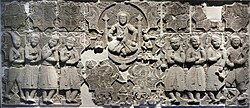Our website is made possible by displaying online advertisements to our visitors.
Please consider supporting us by disabling your ad blocker.
Ganzhou Uyghur Kingdom
Ganzhou Uyghur Kingdom 甘州回鶻 | |||||||||
|---|---|---|---|---|---|---|---|---|---|
| 894–1036 | |||||||||
 | |||||||||
| Status | Kingdom | ||||||||
| Capital | Ganzhou (Zhangye) | ||||||||
| Common languages | Old Uyghur language Middle Chinese | ||||||||
| Religion | Manichaeism (official; 894 - c. 980), later Buddhism | ||||||||
| Government | Monarchy | ||||||||
| Idiqut | |||||||||
| History | |||||||||
• Established | 894 | ||||||||
• Disestablished | 1036 | ||||||||
| |||||||||
| Today part of | China | ||||||||
| History of the Turkic peoples pre–14th century |
|---|
 |
The Ganzhou Uyghur Kingdom (traditional Chinese: 甘州回鶻; simplified Chinese: 甘州回鹘; pinyin: Gānzhōu Huíhú), also referred to as the Hexi Uyghurs, was established in 894 around Ganzhou in modern Zhangye.[1][2] The kingdom lasted from 894 to 1036; during that time, many of Ganzhou's residents converted to Buddhism.[3]
The Hexi Corridor, located within modern Gansu, was traditionally a Chinese inroad into Central Asia. From the 9th to 11th centuries this area was shared between the Ganzhou Uyghurs and the Guiyi Circuit. By the early 11th century both the Uyghurs and Guiyi Circuit were conquered by the Tangut people of the Western Xia dynasty.[4]
The Ganzhou Uyghur rulers were descended from the House of Yaglakar.[5]
- ^ Golden 2011, p. 47.
- ^ Millward 2007, p. 46.
- ^ Bosworth 2000, p. 70.
- ^ Bell, Connor Joseph. The Uyghur Transformation in Medieval Inner Asia: From Nomadic Turkic Tradition to Cultured Mongol Administrators. pp. 65–69. ISBN 9780549807957. Retrieved 21 December 2008.[permanent dead link]
- ^ Cite error: The named reference
knowledgewas invoked but never defined (see the help page).
Previous Page Next Page


